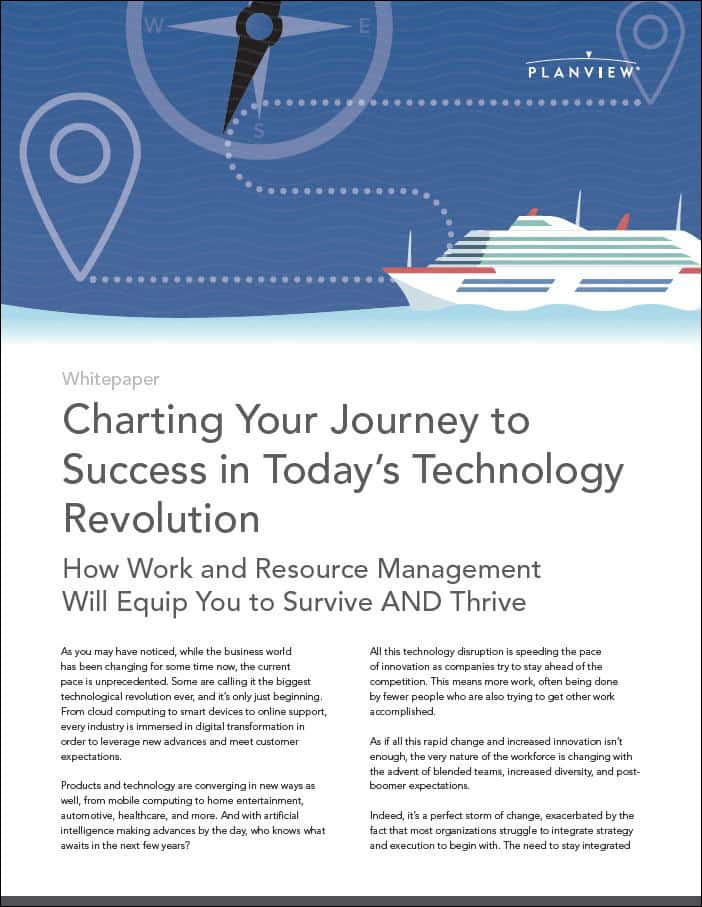
First the good news: we’re all in the same boat when it comes to coping with massive digital transformation and disruption. The not-so-great news? This full-steam ahead approach to technology is making waves that require a new management mindset and a broader toolset. Did we mention this rapid innovation—from cloud computing to AI to IoT—is all occurring alongside a rapidly changing modern workforce?
OK, don’t panic yet. It’s possible to navigate through the rapidly changing market forces and get your sea legs. In our new white paper, Charting Your Journey to Success in Today’s Technology Revolution, best-selling author, speaker, and consultant Jerry Manas takes a deep dive into new ways of managing and executing work to meet the expectations of today’s workforce. He explains how work and resource management can bring together domains that are typically managed independently—albeit in a disjointed fashion.
Simply put, today’s organizations can no longer manage product portfolios, plan strategy, and improve collaboration in isolated silos. While work and resource management can offer greater agility and alignment, most organizations will have to alter their mindset about how work gets done. For starters, here are some best practices:
- Projects should always be prioritized, scheduled, managed, and assessed in the context of their respective outcomes. Did you know that by 2020, 40% of organizations will embrace the product portfolio paradigm to manage technology investments?
- Capabilities must be strategic, as strategy is not enough. What are your company’s core capabilities in terms of people, processes, and technology? Do you know where to invest to improve them?
- Organizations must integrate work and resources to broaden resource planning. Do you know how to optimize work and resources to maintain your applications, infrastructure, or services, and how they all connect? In fact, 52 percent of organizations can’t adequately perform scenario planning.
- Embrace unstructured work done both individually and in teams. In fact, two out of three project leads are “accidental project managers” with no formal training. Only 10-15% of this unstructured work is strategic in nature. This is where work collaboration methods and tools can make a huge difference.
Even with a new outlook, many enterprises will need to throw out their old ways of thinking about work and resources to chart the right course. Check out the infographic! To gain significant value and agility, they will need to:
- Shift to continuous planning to align goals with market realities. Did you know 85% of IT organizations deviate from the annual plan several times per year? This is evolving even further from quarterly to monthly, and ongoing as new work and governance issues arise.
- Maximize virtual and global teams. Did you know, 79% of knowledge workers report working always or frequently in dispersed teams? The “average” team can be global, multicultural, multigenerational, virtual, remote, or co-located. Expand your expertise and increase efficiencies by being open to virtual and remote workers.
- Leverage technology effectively to connect with customers. Are you connected to your customers? Do your products take advantage of new technology opportunities? A staggering 50 billion devices will be connected by 2020. Will yours be among them?
- Support diverse work methods and mobility to maximize productivity. There is not just one way to work effectively. Instead, you must embrace multiple work methods and integrate the various tools as needed. An overwhelming 77% of millennial workers want greater mobile connectivity.
To learn more and take a deeper look at what roles will help in your quest – get your copy of the white paper, Charting Your Journey to Success in Today’s Technology Revolution, now.
I would like to hear from you. How are you and your organization navigating all this change? What technology are you using to get you there? Share by leaving a comment below.





